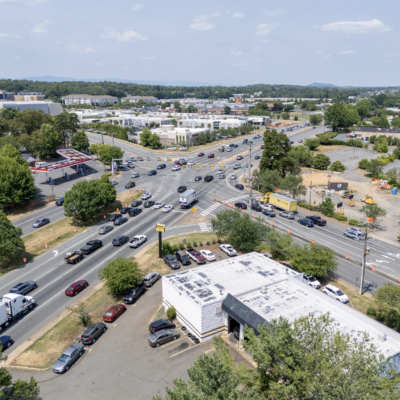When the McIntire Interchange opened in February, it was the last piece in a thoroughfare puzzle that had been in play since the Albemarle Board of Supervisors first approved the Meadow Creek Parkway in 1967. The 2.3-mile road, now known as the John Warner Parkway, was envisioned as a way to smoothly stream traffic between downtown and East Rio Road.
Instead, after two years of interchange construction, some complain traffic is worse than ever. Many are avoiding lengthy waits at the interchange at the U.S. 250 Bypass by taking Park Street, which got its own VDOT-mandated signals at the bypass ramps in June and has traffic backed up as well. And City Councilor Bob Fenwick says the city’s response to those complaints “has been a problem.”
After the interchange ribbon was cut, for a brief time it was possible to zip down McIntire Road from downtown without a stop and hop onto the bypass. More common recently: traffic backed up a half mile at rush hour to the ball fields on McIntire Road.
“I was pretty frustrated by it,” says Belmont resident Sarah Otto. “You couldn’t take a left onto the bypass because the light only allows five cars through.” Add to that, a second set of lights remains tantalizingly green to those trapped behind the red.
“I started taking Park Street,” says Otto. “When the lights went in there, it was pretty frustrating. Now I take Locust.”
“It’s a debacle,” says John Hill, who lives off Park on Evergreen Avenue. Based on his anecdotal evidence, he says traffic has “gotten worse” and he’s seen it backed up farther on Park than ever before, even on Sundays.
“And the worst part is,” says Hill, “the initial intent [of the parkway] was to get traffic off the smaller streets like Park.”
Before the traffic lights were installed on Park, “the most amazing thing is when there were flashing lights,” says Hill. “People used their own judgment and there was much better traffic flow.”
Missy Creasy, assistant director for Neighborhood Development Services, says a traffic signal where people have never had to stop “is a really big change.” The interchange and Park Street lights are interconnected and speak to one another “to facilitate safe traffic flow,” she says. She also notes traffic has been heavier since school started.
On September 3, city spokesperson Miriam Dickler said that the intersection lights at both McIntire Road and Park Street were being adjusted that day. “Twelve citizens have registered e-mail complaints about Park Street,” since June, says Dickler. Comments also were made about the McIntire lights early on, but not as many as were received about Park Street, she says.
Traffic engineers are adjusting the green time of traffic lights at McIntire, says Dickler, and changing the phasing on the Park Street lights to allow more traffic up the ramps and to stack on the bridge. Engineers also will adjust traffic detection equipment there, she says.
How well did the adjustment work? That afternoon on McIntire Road, shortly after 5pm, traffic was backed up an additional two-tenths of a mile to the Albemarle County Office Building.
At 5pm, the first set of lights one encounters heading north or south on McIntire stays green for 35 seconds, and the first set at Park are green for 50 seconds, according to the city’s Jeanette Janiczek.
“This isn’t the first time they’ve been adjusted,” says Dickler. “It’s more an art than a science. Getting it to its optimal use is an ongoing process. We’ll keep monitoring and keep getting feedback. We’re trying to figure out the best way to adjust those concerns.”
City Councilor Bob Fenwick says he’s received many complaints—not just about the McIntire interchange and Park Street lights, he says, but also from the Birdwood neighborhood, which bore the brunt of construction inconvenience and lost an exit, and from the businesses at McIntire Plaza.
City responsiveness to those complaints “continues to be a problem across the city,” says Fenwick. “That’s a management problem, and it’s a customer service problem.” Fenwick touts the August 1 promotion of Mike Murphy, former director of human services, to assistant city manager. “I’m expecting big improvements,” he says.
Back in November, nine neighborhood leaders wrote City Council complaining about Neighborhood Development Services, which handles traffic engineering, as well as planning and development, and criticizing the department as “out of touch” to the needs of residents. Its longtime director Jim Tolbert departed in February to take the assistant city manager job in Sandy Springs, Georgia, and Alexander Ikefuna came from Mobile, Alabama, to take the director job August 17.
City Manager Maurice Jones says the lights have been tweaked several times in the past two months.
Says Fenwick, “People are just avoiding [the McIntire] intersection and using Park and Locust Avenue instead. They’re avoiding Harris Street and using Rose Hill Drive. All those nearby roads are taking a hit.”
Fenwick describes his use of the new interchange: “I try to avoid it during rush hour.”
With all these drivers avoiding the road that was supposed to ease traffic congestion, doesn’t that negate the purpose of the John Warner Parkway? “Absolutely,” says Fenwick.
But aside from complaints about the traffic lights, signage and 35mph speed limit on the bypass, many are happy the project is finally completed.
“I’ve been real pleased with it,” says Jackie Binder, owner of Circa on Allied Street. “The light sequencing needs to be tweaked.” But it’s easy turning off the bypass to get to her store, she says. “Overall I think it’s great. You can see Circa from the bypass.”





